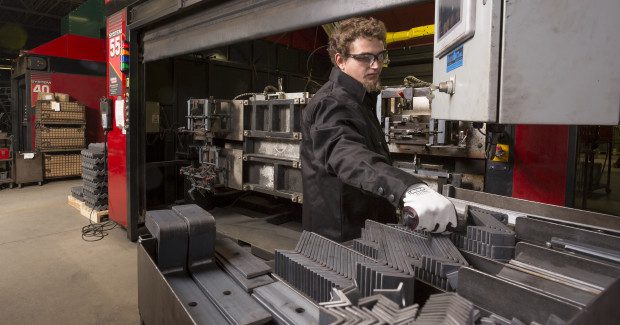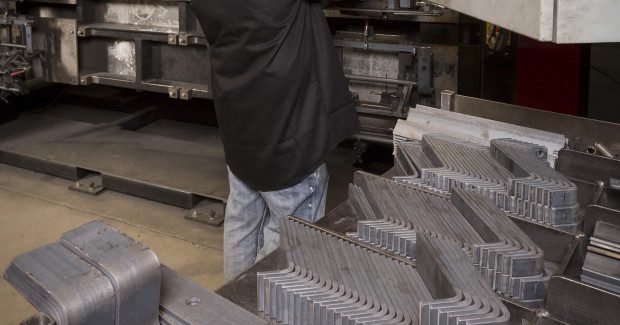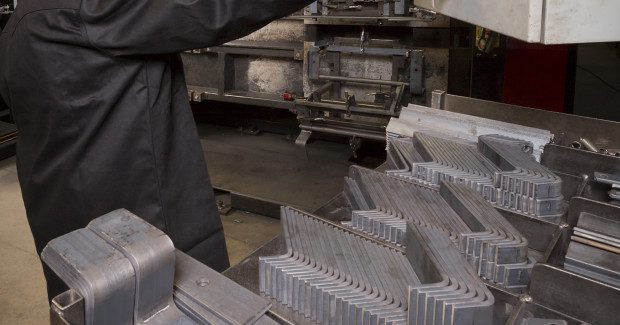How to Make the Most of Your Plasma Cutting System
By following these simple guidelines, using the right machine for your application and mastering some tricks of the trade, you should see increased precision and quality in your plasma cutting process.
Posted: March 3, 2015
Recent advances in plasma cutting technology and torch design allow fabricators to cut parts with unprecedented precision, with less post-process work and reduced labor costs. Most frequently competing on the shop floor with oxyfuel, waterjet and laser cutting, plasma cutting offers distinct advantages over these methods.
Quick and precise, plasma cutting provides improvements in productivity, as well as use of consumables yielding longer life cycles than ever before. Beyond this, plasma cutting also proves beneficial to fabricators who cut a variety of materials of varying thicknesses. With a versatile plasma cutter, you won’t need a waterjet for aluminum and an oxyfuel torch for steel. You can do it all with a single plasma-cutting system.
What’s more, plasma cutting systems may have financial advantages, both at startup and operationally. While a high-quality waterjet machine might cost the same to acquire as an automated plasma cutter, maintenance and abrasive costs can prove to be much higher, putting a dent into long-term return on investment. Other systems, such as a high-wattage laser, can cost as much as three or four times more than a precision plasma system at the time of purchase.
To achieve optimum results when using a plasma cutting system, you’ll want to follow a few key tips to get the highest quality cuts, and maximize the life of the consumables:
- Determine the thickness of materials you most frequently cut. Most plasma cutting power sources are rated on their production piercing ability and maximum amperage. So, for example, if you most often cut materials that are ¼ in thick, a lower amperage plasma cutter will suffice. If you cut metal that’s ½ in or thicker most frequently, look for a higher amperage machine. While a smaller machine might be able to cut through the thicker substrate, chances are it won’t produce a quality cut and instead result in a “severance” cut which leaves dross behind on the workpiece. For best results, don’t attempt to cut or pierce materials outside the capability of the power source being used.
- Start with a clean compressed air supply at the manufacturers specified inlet pressure. Air contaminated by moisture or lubricating oil aerosols can impact cut quality and cause consumable performance issues. Consumables that wear quickly or have black burn marks inside the nozzle or on the tip of the electrode indicate possible air contamination.
- Deviation in plasma gas pressure can also create a consumable issue. If the pressure is set to more than 5 psi above the recommended value, the electrode will wear significantly faster. If it is set to more than 5 psi below the recommended value, the nozzle orifice will rapidly become out of round, affecting cut quality. Following the specified parameters set forth in the manufacturers cutting charts will provide you with the environment for longest consumable life.
- Verify proper piercing height. It can take as long as 4.5 seconds for the plasma arc to pierce through the thickest materials, and during that time, intense gas pressure forces molten steel upward. Piercing too close to the plate can damage or even destroy a shield cap in as little as a single pierce. On the other hand, piercing too far away from the plate can cause a misfire, which diminishes electrode life. Consult your system’s owner’s manual to determine the appropriate pierce height for the material you are cutting.
- Verify proper travel speeds during the cutting process. When you maintain the correct cutting speed for the amperage and material thickness being cut, the molten metal spray will blow out the bottom of the plate, eliminating most if not all dross accumulation. If the torch is cutting too slowly, you’ll create slow-speed dross, an accumulation of metal that resembles a welding bead, on the parts bottom edge. This type of dross is commonly produced when cutting small holes, and can be easily removed. Cutting too fast will create dotted high-speed dross on the top and/or bottom surface, which can only be removed by secondary grinding. Always refer to the manufacturers cutting charts for recommended cutting speeds.
- Don’t allow the consumables to touch the workpiece when cutting. This is particularly true when using current levels of 30 amps or more. Doing so will drastically reduce nozzle life because the plasma arc will double arc through the nozzle.
- Ensure that the plasma torch is cutting in the proper direction for the most precise work. Remember, the perimeter of the part being produced must be cut in a clockwise direction, and all holes and slots must be cut counterclockwise. The reason for this is that the shape of the plasma jet, which is created by swirling gases, allows for only its right side to produce a quality cut.
By following a few simple guidelines, using the right machine for your application and mastering some tricks of the trade, you should see increased precision and quality in your plasma cutting process.


















